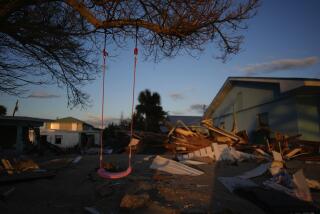In hurricane’s wake, tempers swell
- Share via
HOUSTON — As recovery efforts along the Gulf Coast slowly expanded Wednesday, local leaders and federal officials resolved their spat over logistical tie-ups that kept thousands of residents from getting food and supplies from government aid stations.
But in hard-hit Galveston Island, Hurricane Ike’s widespread devastation left frazzled city officials sniping at one another about the crush of residents who wanted to return to a place that medical experts said is a health hazard.
More than 1 million people in the region are without electricity, and tens of thousands are still in shelters across Texas. But Houston residents got good news when authorities said the city’s water was safe to drink.
On Bolivar Peninsula northeast of Galveston, where most homes and businesses were swept away by a powerful tidal surge, 200 to 250 people are refusing to leave. The peninsula has essentially become an island, cut off by flooded roads and mountains of sand and debris.
State officials worry that it will take weeks to restore basic utilities in towns like Galveston and communities near the Texas-Louisiana border because power substations have been demolished and key infrastructure systems are down.
In Houston, Homeland Security Secretary Michael Chertoff met with local officials and promised to deal with the problems of supply distribution.
Earlier in the week, a federal employee sent away a supply truck that arrived late in the day at one Harris County distribution center, citing concerns about leaving the goods unguarded overnight. At other centers, crowds stood in line for hours, only to learn that there were no supplies.
A clearly frustrated Houston Mayor Bill White and Harris County Judge Ed Emmett took over the logistics operations Tuesday. They opened extra centers and ordered supply trucks to drive through the night so that supplies would be available at daybreak to the region’s hardest-hit areas.
By Wednesday, some of the problems were easing.
At a distribution site on Navigation Boulevard in southwest Houston, a line of cars stretched for several blocks. But the traffic flow moved quickly and smoothly.
Tiffany Warren and her 9-month-old son had fled her flooded apartment for her mother’s place, where the electricity and plumbing returned Wednesday.
“This is the first real help we’ve gotten,” Warren said of the relief site. The food, water and ice were “a real blessing after some rough days.” She said she had been living off supplies bought at a pharmacy Sunday after a three-hour wait.
Though organizers refused to turn anyone away, Anthony Marquez, an events company worker who was helping direct traffic, was annoyed by people who returned several times.
He was worried that no supplies would remain by the time people getting off work came to get their share.
“Look at the Impala,” Marquez said, pointing to a car stuffed with supplies. “They’ve already gone back four times. Why be so greedy?”
In the 29 Texas counties that President Bush declared disaster areas, 63 centers handed out supplies, Chertoff said.
“For people who are hot, hungry and thirsty, any delay is too much delay,” Chertoff said. “I’m not going to promise you that we won’t have problems. . . . But I can tell you that when we have a hitch, we’re going to jump on it.”
Early estimates put the storm’s destruction at more than $11 billion in insured losses, making it the fifth-most-expensive catastrophe in U.S. history, according to the Insurance Information Institute.
The Texas attorney general’s office said it had received more than 1,000 complaints about price gouging on gasoline, food and other supplies on the Gulf Coast, and at hotels and motels in the state.
Ike’s U.S. death toll grew to 50. Five people died on Galveston Island: Three had serious medical conditions before the hurricane, one drowned and one was found in a hotel room, the Associated Press reported.
The only highway onto Galveston Island was jammed for miles Wednesday with residents trying to return to check on their homes -- only to be turned away.
City officials, who had instituted a “look and leave” program Tuesday only to abort it late in the day, said they were working on a plan to allow residents to return in shifts. Until then, Galveston City Manager Steve LeBlanc said the residents who remained on the island should leave.
Conditions on the island are “a setup for food-borne illnesses,” said Dr. David Lakey, the state health commissioner. The University of Texas Medical Branch at Galveston, with the island’s only hospital, is not capable of treating serious illnesses or major trauma. It has seen an upsurge in respiratory ailments and injuries from falls or burns, Lakey said.
Galveston leaders began snapping at each other over whether to extend the city’s state of emergency. As tempers grew, Councilman Danny Weber Sr. spoke harshly to Mayor Lyda Ann Thomas and another official, according to footage recorded by KHOU-TV, the Houston CBS affiliate.
“You’ve never worked an emergency in your life, neither of you, and you don’t know what it is,” Weber said. “. . . There are decisions made here that you cannot take 30 minutes worth to debate, to play with, just so you can have media attention.”
Weber later stormed out of the room.
--
Times staff writer DeeDee Correll contributed to this report.
More to Read
Sign up for Essential California
The most important California stories and recommendations in your inbox every morning.
You may occasionally receive promotional content from the Los Angeles Times.











